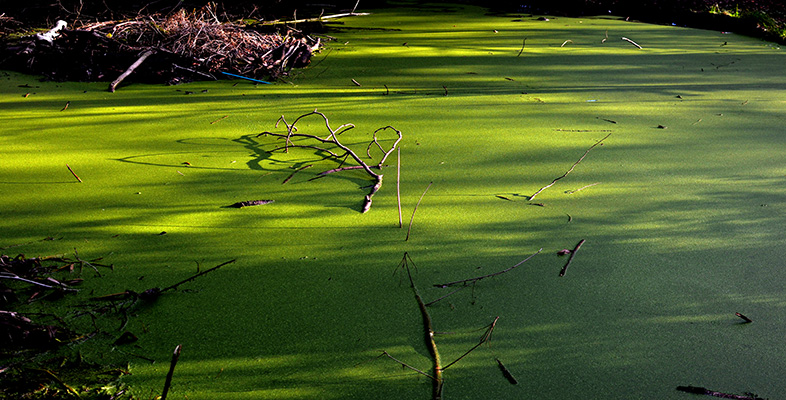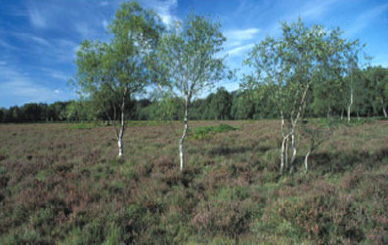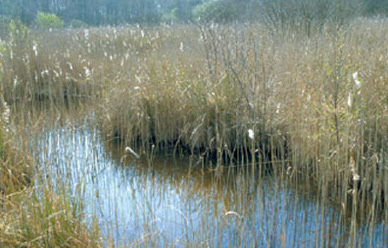2.3 Effects on terrestrial vegetation
SAQ 13
Why do you think nitrogen is becoming increasingly available to terrestrial ecosystems in many parts of the world)
Answer
Emission of nitrogen oxides from burning fossil fuel and of ammonia from intensive agriculture result in nitrogen compounds being transported and deposited by atmospheric processes.
Some suggested global scenarios for the year 2100 identify nitrogen deposition (together with land use and climate change) as one of the most significant ‘drivers’ of biodiversity change in terrestrial ecosystems.
Atmospheric deposition of nitrogen, together with the deposition of phosphorus-rich sediments by floods, can alter competitive relationships between plant species within a terrestrial community. This can cause significant changes in community composition, as species differ in their relative responses to elevated nutrient levels. As is the case with aquatic vegetation, terrestrial species that are able to respond to extra nitrogen and phosphorus with elevated rates of photosynthesis will achieve higher rates of biomass production, and are likely to become increasingly dominant in the vegetation. Atmospheric deposition of nutrients can reduce, or even eliminate, populations of species that have become adapted to low nutrient conditions and are unable to respond to increased nutrient availability. Some vegetation communities of conservation interest are directly threatened by atmospheric pollution.
In Britain, rare bryophytes are found associated with snowbeds (Figure 2.12). Most of the late-lying snowbeds in Britain are in the Central Highlands of Scotland, which are also areas of very high deposition of nitrogenous air pollutants. Snow is a very efficient scavenger of atmospheric pollution and melting snowbeds release their pollution load at high concentrations in episodes known as ‘acid flushes’. The flush of nitrogen is received by the underlying vegetation when it has been exposed following snowmelt. Concentrations of nutrients in the meltwater of Scottish snowbeds have already been shown to damage underlying bryophytes, including a rare species called Kiaeria starkei. Recovery from damage is slow, and sometimes plants show no signs of recovery even four weeks after exposure to polluted meltwater. Given the very short growing season, this persistent damage can greatly reduce the viability and survival of the plants. Tissue nitrogen concentrations in Kiaeria starkei have been shown to be up to 50% greater than that recorded in other upland bryophytes. This example emphasizes the potential threat of atmospheric pollution to snowbed species, and suggests that some mountain plant communities may receive much higher pollution loadings than was previously realized.
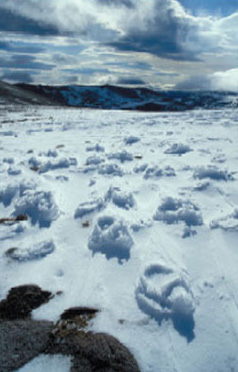
The deposition of atmospheric nitrogen can be enhanced at high altitude sites as a consequence of cloud droplet deposition on hills. Sampling of upland plant species at sites in northern Britain has shown marked increases in nitrogen concentration in leaves with increasing nitrogen deposition, which is, in turn, correlated with increasing altitude. The productivity of the species was also found to increase in line with the amount of nitrogen deposited. Plant species can therefore respond directly to elevated levels of nitrogen. In the longer term, the relative dominance of species is likely to alter depending on their ability to convert elevated levels of deposited nitrogen into biomass.
SAQ 14
What will be the effect on species diversity of increasing biomass?
Answer
As biomass increases beyond an optimal value, species diversity will decline.
Atmospheric pollution can also affect plant-insect interactions. Unusual episodes of damage to heather moorland in Scotland have been caused by the winter moth (Operophtera brumata) in recent years. It has been suggested that this may be due to the effects of increased nitrogen supply on heather plants, including increased shoot growth and a decrease in the carbon : nitrogen ratio in plant tissues. Winter moth larvae have been shown to grow faster on nitrogen-treated heather plants, so it is possible that increased atmospheric deposition of nitrogen may have a role in winter moth outbreaks and the associated degradation of heather moorland in upland Britain.
Although uplands are more susceptible to atmospheric deposition of nitrogen, the effects can be seen in lowland areas too. Nitrogen deposition and the consequent eutrophication of ecosystems is now regarded as one of the most important causes of decline in plant species in the Netherlands. Figure 2.13 shows how the number of grassland species of conservation interest in south Holland declines as the nitrogen load increases. The maximum percentage of species (approximately 95%) is possible at a nitrogen load of about 6 kg N ha−1 yr−1. At loads higher than 10 kg N ha−1 yr−1 the number of species declines due to eutrophication effects, and below 5 kg ha−1 yr−1nitrogen may be too limiting for a few species.
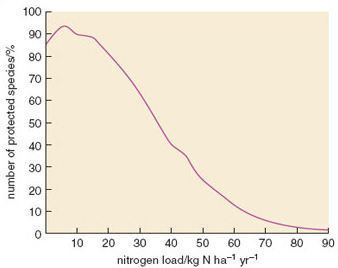
A significant proportion of important nature conservation sites in Britain are subject to nitrogen and/or sulfur deposition rates that may disturb their biological communities. Lowland heath ecosystems, for example, have a high profile for conservation action in Britain. They typically have low soil nutrient levels and a vegetation characterized by heather (Calluna vulgaris). Under elevated atmospheric deposition of nitrogen, they tend to be invaded by taller species, including birch (Betula spp., Figure 2.14), bracken (Pteridium aquilinum) and the exotic invader, rhododendron (Rhododendron ponticum).
A large number of SSSIs in the UK, designated as such on account of their terrestrial plant communities, are considered to have been damaged by eutrophication. This has been identified as a factor in the decline of some important UK habitats, including some identified for priority action under the UK’s Biodiversity Action Plan (BAP). Wet woodlands, for example, occur on poorly drained soils, usually with alder, birch and willow as the predominant tree species, but sometimes oak, ash or pine occur in slightly drier locations. These woodlands are found on floodplains, usually as a successional habitat on fens, mires and bogs, along streams and in peaty hollows. They provide an important habitat for a variety of species, including the otter (Lutra lutra, Figure 2.15), some very rare beetles and craneflies. They also provide damp microclimates, which are particularly suitable for bryophytes, and have some unusual habitat features not commonly found elsewhere, such as log jams in streams which support a rare fly, Lipsothrix nigristigma. Wet woodlands occur on a range of soil types, including relatively nutrient-rich mineral soils as well as acid, nutrient-poor ones. Nevertheless, many have been adversely affected by eutrophication, resulting in altered ground flora composition and changes in the composition of invertebrate communities.
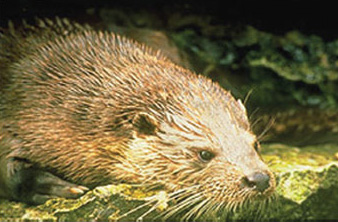
Nutrient enrichment can also affect habitats found in drier sites. Eutrophication caused by runoff from adjacent agricultural land has been identified as a cause of altered ground flora composition in upland mixed ash woods for example. These woods are notable for bright displays of flowers such as bluebell (Hyacinthoides non-scripta), primrose (Primula vulgaris) and wild garlic (Allium ursinum, Figure 2.16a). They also support some very rare woodland flowers which are largely restricted to upland ash woods, such as dark red helleborine (Epipactis atrorubens, Figure 2.16b) and Jacob’s ladder (Polemonium caeruleum).
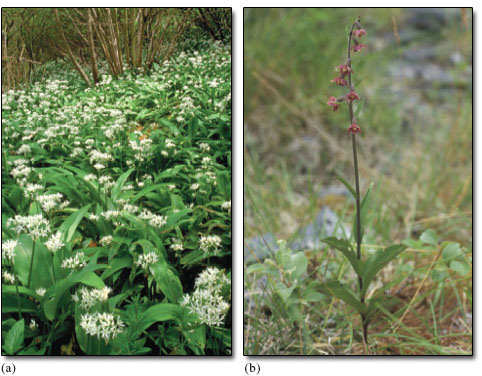
Other terrestrial UK BAP habitats that may be adversely affected by nutrient enrichment from agricultural fertilizers or atmospheric deposition include lowland wood pasture, lowland calcareous grassland, upland hay meadows and lowland meadows; again the result can be altered plant species composition.
Coastal marshes and wetlands in many parts of the world have been affected by invasion of ‘weed’ or ‘alien’ species. Eutrophication can accelerate invasion of aggressive, competitive species at the expense of slower growing native species. In the USA, many coastal marshes have been invaded by the common reed (Phragmites australis, Figure 2.17). Phragmites is a fierce competitor and can outcompete and entirely displace native marsh plant communities, causing local extinction of plants and the insects and birds that feed on them. Phragmites can spread by underground rhizomes and can rapidly colonize large areas. However, it is the target of conservation effort in some areas, including Britain, because the reedbeds it produces provide an ideal habitat for rare bird species such as the bittern (Botaurus stellarus). But its spread is not always beneficial for nature conservation, as it often results in the drying of marsh soils, making them less suitable for typical wetland species and more suitable for terrestrial species. This is because Phragmites is very productive and can cause ground levels to rise due to deposition of litter and the entrapment of sediment. Thus eutrophication can also play an indirect part in the loss of wetland habitats.
